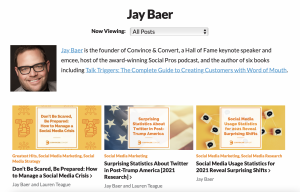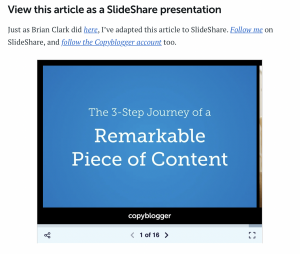9 Examples That Demonstrate The Power of Repurposing Content
Do you notice a lot of stagnant views on your content when you’re reviewing your site’s metrics?
These dips and plateaus in traffic are normal, but that doesn’t mean that you can’t do something about it. Sometimes all you really need is a way to refresh your content—and that’s where repurposing content comes in. By this, we mean taking something that you’ve already created, something that you know already works, and breathe new life into it. This can help you reach new audiences, reinforce your message, and improve organic visibility.
Always keep in mind what Kevan Lee, former VP of marketing at Buffer, said—repetition is important when it comes to marketing. And if we follow Marketing’s Rule of Seven, it takes around seven times before we can successfully convince people and close deals.
Through the years, you may have come across some great examples of repurposed content that you didn’t even know was repurposed. Here are some.
1. Turning old videos into multiple, shareable content pieces
Jay Baer, who founded Convince and Convert was known for creating three-minute informational videos on topics that ranged from everything from business to social media. To maximize the use of these, his team takes the videos and turns them into other content pieces that expand his reach.
For example, his videos have been known to be turned into podcasts, or blog topics for the Convince and Convert or Jay Today website. They also often use the same videos for LinkedIn posts or publish them as content on Medium.

2. Compiling old posts into a whole book
Content Marketing Institute founder Joe Pulizzi, back in 2013, committed to publishing an entire book about content marketing. Unfortunately, he didn’t have time to write 25 chapters. Weekly, he already had to produce content for his LinkedIn page and the Content Marketing Institute blog. To fulfill his required book pages, he took these blog posts to create his new book, Epic Content Marketing.
3. Use slide decks to repurpose old content
Copyblogger has always been known for the quality of content they produce covering topics such as copywriting and content marketing. One of the most shared pieces they’ve ever created was a blog post titled The 3-Step Journey of a Remarkable Piece of Content.
To make sure this blog post reached new audiences, they made sure that it was also available as a SlideShare. This repurposed piece has gained thousands of views.

4. Taking old content and publishing it on new platforms
Ben Hardy of Goinswriter’s objective for starting his blog was simple—grow his audience. He knew that gaining the readership he wanted would help him build traction to connect with a traditional publisher and get his work out in the world. He also knew that posting on his own blog wasn’t enough.
So, he took his blog content and repurposed it so he could publish material on Medium.
As his content went viral on Medium, it drove new audiences to his site. He also made sure that his call to action and opt-in from the Medium article offered an option to subscribe to his blog. It wasn’t long before he managed to grow his subscriber list from 0 to 20,000.
5. Leveraging old content to develop a new product
Bryan Harris at Videofruit reinvented the product launch sequence through content marketing.
He basically took his most popular posts and gathered the data behind them to understand the needs and interests of his readers. From there, he was able to develop a new product and introduce it to his followers—knowing they were likely to purchase it. The experiment was a success and he managed to earn $10,000 within 24 hours of the launch.
6. Transforming old blogs into audio blogs
Hosts of the popular Internet Business Mastery podcast Jeremy and Jason were already busy maintaining their individual blogs. However, with the intent of raising their download numbers, they decided to conduct an experiment. They took their most popular posts, recorded themselves reading them, and uploaded the audio on their podcasts.
The result? Their audio blogs surpassed their featured podcasts numbers, seeing 60–100% more downloads.
7. Using old blogs to create an eBook
ProBlogger Founder Darren Rowse began gaining recognition in the industry after his series “31 Days to Build a Better Blog” received a lot of positive feedback. With the goal of further monetizing content and streamlining his efforts, he took the current content he had and repackaged the entire series into an eBook, available for purchase for $29.99.
The book is still available today and is being bought and used for online courses.
8. Refreshing dated content with new data
Brian Dean of Backlinko had a simple but brilliant idea for repurposing content after he received a great case study from a user. Instead of posting the review as a case study on his site, he instead took an older but popular blog post, updated the content with the case study to support its content, and promoted that piece again.
It’s a simple update that garnered him over 140,000 new views.
9. Turning creative executions into traditional content
We often rack our brains to find fresh and creative ways to present our content, but Moz had a different approach. The company is well known for creating Whiteboard Friday videos, which offer a visual yet informative approach to whatever topic they’re tackling. These videos are distributed individually, but they have made an effort to turn these into blog posts complete with video transcriptions.
The bottom line—repurposing content works. In fact, Buffer conducted an experiment where they stopped producing new content and started repurposing old content for a while. Their efforts led to over 4% growth, with SlideShares gaining hundreds of thousands of new views, and Medium posts capturing new readers’ interest.
So, we hope these nine great examples of how you can repurpose content to capture new audiences and boost organic traffic inspire you to do the same for your own brand.
If you want to learn more, reach out to us. Book a consultation or get started with Leadspanda to find out how we can help you.
For any questions, leave a comment below or check out our LinkedIn or Twitter.
Share This Story
8 Comments
Leave A Comment
Get the latest growth ideas, strategies, and best practices delivered to your inbox.
Quick read that helps 7000+ subscribers.









[…] making sure that you diversify your content to address the evolving needs of your audience. Don’t just stick to blogging, explore other […]
Thanks for sharing. It’s very useful content. I follow your blog.
It’s not often that we come across content that really resonates with us, but this one is a standout. From the writing to the visuals, everything is simply wonderful.
From the insightful commentary to the captivating writing, every word of this post is top-notch. Kudos to the author for producing such fantastic content.
Drop a link to your favorite blog post of yours in the comments below, I’d love to read more.
It means the world to us to hear such positive feedback on our blog posts. We strive to create valuable content for our readers and it’s always encouraging to hear that it’s making an impact.
Your blog has become my daily dose of positivity and inspiration It’s a space that I always look forward to visiting
Thank you for the awesome content, it’s always appreciated